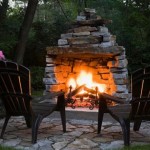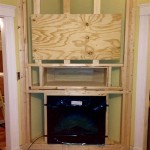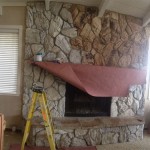Cool Fireplace Mantels: A Guide to Enhancing Your Hearth
The fireplace mantel serves as a focal point in any room, offering an opportunity to showcase personal style and architectural details. Beyond its aesthetic value, the mantel also provides a functional surface for displaying treasured possessions, artwork, and seasonal decorations. Selecting a "cool fireplace mantel" involves considering a variety of factors, including material, design, size, and the overall architectural context of the space. This article explores different types of fireplace mantels, offering guidance on choosing the appropriate style to complement both traditional and contemporary interiors.
The term "cool fireplace mantel" can be subjective, encompassing a wide range of styles from minimalist designs to elaborate, historically inspired pieces. The definition often depends on current trends and individual preferences. However, certain elements consistently contribute to a mantel's perceived coolness: innovative use of materials, unique design features, and the ability to seamlessly integrate with the surrounding décor. A well-chosen mantel enhances the fireplace's visual presence and contributes to the room's overall ambiance.
The selection process should begin with an assessment of the existing fireplace and its surrounding architecture. Considerations include the fireplace opening's size and shape, the material of the fireplace surround, and the room's overall style. A traditional room might benefit from a mantel crafted from wood with intricate carvings, while a modern space might call for a sleek, minimalist mantel made from concrete or metal. The key is to achieve a harmonious balance between the mantel and the surrounding elements.
Safety is a paramount consideration when selecting and installing a fireplace mantel. The mantel must be constructed from fire-resistant materials and installed at a safe distance from the fireplace opening. Local building codes often specify the minimum distance required between the mantel and the firebox. It is crucial to consult with a qualified professional to ensure that the mantel meets all safety requirements. Furthermore, the weight of the mantel must be adequately supported by the wall to prevent it from collapsing.
Understanding Mantel Materials
The material used to construct a fireplace mantel significantly impacts its aesthetic appeal and durability. Common mantel materials include wood, stone, concrete, and metal, each offering distinct advantages and disadvantages.
Wood: Wood is a classic choice for fireplace mantels, offering warmth, versatility, and the ability to be easily customized. Different types of wood, such as oak, cherry, maple, and pine, offer varying grain patterns and colors. Wood can be stained, painted, or left natural to complement a wide range of interior styles. Intricate carvings and moldings can be added to wood mantels to create a more traditional look. However, wood is susceptible to heat damage and requires regular maintenance to prevent cracking or warping. It is imperative to use kiln-dried wood and to ensure adequate separation from the fireplace opening to minimize the risk of fire.
Stone: Stone mantels exude a sense of permanence and elegance. Options include marble, granite, limestone, and slate, each with unique veining and color variations. Stone is highly fire-resistant and durable, making it a practical choice for fireplace mantels. Stone mantels can be simple and understated or elaborately carved, depending on the desired aesthetic. However, stone is also a relatively heavy material, requiring professional installation to ensure proper support. The cost of stone mantels can be considerably higher than that of wood or other materials.
Concrete: Concrete mantels offer a modern and industrial aesthetic. Concrete can be molded into various shapes and sizes, allowing for a high degree of design flexibility. It can be stained or polished to achieve different textures and colors. Concrete is also fire-resistant and relatively low-maintenance. However, concrete mantels can be heavy and require specialized installation techniques. The raw, industrial look of concrete may not be suitable for all interior styles, making it essential to carefully consider its compatibility with the overall décor.
Metal: Metal mantels provide a sleek and contemporary look. Options include steel, wrought iron, and brass, each offering a distinct visual appeal. Metal mantels can be powder-coated or painted to achieve different colors and finishes. They are relatively lightweight and easy to install. Metal is also fire-resistant and durable. However, metal can conduct heat, making it necessary to ensure adequate separation from the fireplace opening to prevent burns. The minimalist aesthetic of metal mantels makes them particularly well-suited for modern and contemporary interiors.
The selection of mantel material should align with the overall design vision and budget. Each material offers unique aesthetic and functional properties that contribute to the fireplace's overall impact.
Exploring Different Mantel Styles
Beyond the material, the style of the fireplace mantel plays a crucial role in defining the room's aesthetic. Different styles can evoke different moods and complement specific architectural periods. Understanding the nuances of various mantel styles is essential for selecting a mantel that effectively enhances the fireplace's presence.
Traditional: Traditional mantels often feature elaborate carvings, moldings, and decorative details. They are typically crafted from wood and stained or painted in classic colors. Traditional mantels often incorporate elements such as fluted columns, dentil moldings, and detailed embellishments. These mantels are well-suited for classic and formal interiors, adding a touch of elegance and sophistication. They are often paired with ornate fireplace surrounds and period-appropriate accessories.
Modern: Modern mantels are characterized by clean lines, minimalist designs, and a focus on functionality. They are often crafted from materials such as concrete, metal, or glass. Modern mantels typically lack intricate details and emphasize simplicity and elegance. They may feature geometric shapes, smooth surfaces, and a neutral color palette. Modern mantels are well-suited for contemporary interiors, creating a sleek and streamlined look. They are often paired with minimalist fireplace surrounds and modern artwork.
Rustic: Rustic mantels evoke a sense of warmth, comfort, and natural beauty. They are often crafted from reclaimed wood or stone and feature a rugged, unfinished appearance. Rustic mantels may incorporate elements such as exposed beams, natural textures, and weathered finishes. These mantels are well-suited for country-style and farmhouse interiors, adding a touch of charm and character. They are often paired with brick or stone fireplace surrounds and rustic accessories.
Floating: Floating mantels are a contemporary design option that creates a visually striking focal point. As the name suggests, these mantels appear to float on the wall, with no visible supports. They are typically crafted from materials such as wood, concrete, or metal and can be customized to various lengths and depths. Floating mantels offer a minimalist and modern aesthetic, creating a sense of spaciousness and airiness. They are well-suited for modern and contemporary interiors, adding a touch of sophistication and elegance. Proper installation is crucial to ensure the mantel's stability and weight-bearing capacity.
Beam: A beam mantel is typically a single, robust piece of wood, often reclaimed or sourced for its distinctive character. These mantels emphasize natural grain patterns, knots, and imperfections, adding a rustic and organic feel to the room. Beam mantels can be installed in various ways, including floating or supported by corbels. They are well-suited for a range of interior styles, from farmhouse to modern rustic, and provide a substantial, grounding presence above the fireplace.
The choice of mantel style should reflect the overall design aesthetic of the room and the desired mood. A well-chosen mantel style can significantly enhance the fireplace's visual impact and contribute to the room's overall ambiance.
Considering Size and Proportion
The size and proportion of the fireplace mantel are crucial considerations. A mantel that is too large can overwhelm the fireplace and the surrounding space, while a mantel that is too small can appear insignificant and out of place. The ideal mantel size should be proportional to the fireplace opening and the room's dimensions.
Mantel Width: The mantel's width should be slightly wider than the fireplace opening. A general rule of thumb is to extend the mantel at least 6 to 12 inches beyond each side of the firebox. This provides a balanced and visually appealing look. The width should also be proportionate to the room's overall size. A larger room can accommodate a wider mantel, while a smaller room might require a narrower mantel.
Mantel Depth: The mantel's depth, or the distance it projects from the wall, should be considered in relation to its height and width. A deeper mantel can provide more surface area for displaying items, but it can also make the fireplace appear bulky. A shallower mantel creates a more streamlined look. The ideal depth will depend on individual preferences and the desired functionality of the mantel.
Mantel Height: The mantel's height, or the distance from the floor to the top of the mantel, is another important consideration. The height should be proportionate to the fireplace opening and the room's ceiling height. A mantel that is too high can make the fireplace appear distant, while a mantel that is too low can make it appear insignificant. Local building codes often specify the minimum distance between the fireplace opening and the bottom of the mantel to ensure safety.
Room Proportion: Ultimately, the mantel's dimensions should be in harmony with the room's overall proportions. In a large room with high ceilings, a larger and more elaborate mantel might be appropriate. In a smaller room with lower ceilings, a smaller and more minimalist mantel might be a better choice. Consider the impact of the mantel on the room's overall balance and visual appeal. Using painter's tape to outline the intended mantel size on the wall can be helpful in visualizing the final result before committing to a purchase or installation.
By carefully considering the size and proportion of the fireplace mantel, one can ensure that it effectively enhances the fireplace's presence and contributes to the room's overall design.

53 Best Fireplace Mantel Designs To Ignite Your Creativity Classic White Mantels

10 Fireplace Mantel Decorating Ideas Full Service Chimney

24 Unique Fireplace Mantel Ideas Modern Designs

15 Fireplace Mantel Ideas Modern And Decor

24 Unique Fireplace Mantel Ideas Modern Designs

10 Rustic Fireplace Mantel Ideas Blog Red Door

ᑕ❶ᑐ 15 Creative Electric Fireplace Mantel Ideas For Your Home
:max_bytes(150000):strip_icc()/cozy-outdoor-fire-place-2272001_falld_010_0-577b47d3549d403b951da0efa9d73170.jpg?strip=all)
44 Cozy Ideas For Fireplace Mantels

Fireplace Mantel Decor Ideas Three Ways To Style Your

35 Fireplace Mantel Ideas For A Heavenly Hearth Bored Panda
Related Posts








